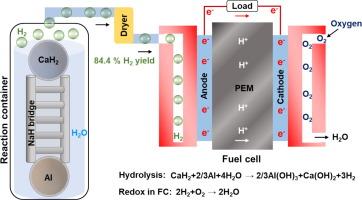On-site hydrolytic H2 production by CaH2/(Al/Si) composites via Na+ bridging effect for fuel cell
IF 14.9
1区 化学
Q1 Energy
引用次数: 0
Abstract
Inorganic materials can solve transportable and on-site hydrolytic hydrogen generation issues. CaH2/(Al/Si) composites are preferable due to their notable chemical properties. However, these composites require pretreatments, an inert environment, and long hours of physical ball milling for high homogeneity and synergistic effects. CaH2 also inhibits the hydrolysis reaction by forming its products on the Al/Si surface, which hinders the direct utilization of composites. This work represents the first investigation of NaH-CaH2(Al/Si) fuel composites, which greatly overcome these limitations and can be directly used for on-site hydrogen generation and proton exchange membrane (PEM) fuel cells. The NaH-CaH2(Al/Si) fuel composites were prepared by using a straightforward mixing method with variable composition ratios, showing high H2 yield and fuel cell (FC) performance. NaH addition provides the bridge effect, which opens up a new way to enable efficient hydrolysis and greatly enhances the hydrolysis activity of CaH2/(Al/Si) composites. The novel fuel composites (NaH-CaH2/Al) have extraordinary FC performance and a 0.42 W/cm2 peak power density greater than commercial hydrogen generators. It provides high H2 yield 84.4 % for NaH-CaH2/Al and 82 % for NaH-CaH2/Si compared to NaOH-CaH2(Al/Si), NaCl-CaH2(Al/Si), and KCl-CaH2(Al/Si) composites. The NaH bridge effect hinders the direct water contact and stops the formation of Ca(OH)2 around Al/Si, which provides adequate pathways for the CaH2(Al/Si) hydrolysis. The impressive capabilities of novel fuel composites are anticipated to offer practical uses in fuel cells, automobile applications, and portable/on-board H2 generation.

基于Na+桥接效应的CaH2/(Al/Si)复合材料燃料电池现场水解制氢研究
无机材料可以解决可运输和现场水解制氢问题。CaH2/(Al/Si)复合材料具有显著的化学性能,是较好的选择。然而,这些复合材料需要预处理、惰性环境和长时间的物理球磨才能达到高均匀性和协同效应。CaH2通过在Al/Si表面形成产物抑制了水解反应,阻碍了复合材料的直接利用。这项工作代表了NaH-CaH2(Al/Si)燃料复合材料的首次研究,它极大地克服了这些限制,可以直接用于现场制氢和质子交换膜(PEM)燃料电池。采用直接混合的方法制备了NaH-CaH2(Al/Si)燃料复合材料,具有较高的H2产率和燃料电池(FC)性能。NaH的加入提供了桥接效应,为CaH2/(Al/Si)复合材料的高效水解开辟了一条新途径,大大提高了其水解活性。新型燃料复合材料(NaH-CaH2/Al)具有优异的FC性能,峰值功率密度比商用氢气发生器高0.42 W/cm2。与NaOH-CaH2(Al/Si)、NaCl-CaH2(Al/Si)和KCl-CaH2(Al/Si)复合材料相比,NaH-CaH2/Al和NaH-CaH2/Si的H2产率分别为84.4%和82%。钠桥效应阻碍了Al/Si与水的直接接触,阻止了Ca(OH)2在Al/Si周围的形成,为CaH2(Al/Si)水解提供了充足的途径。新型燃料复合材料令人印象深刻的能力有望在燃料电池、汽车应用和便携式/车载氢气生成方面提供实际应用。
本文章由计算机程序翻译,如有差异,请以英文原文为准。
求助全文
约1分钟内获得全文
求助全文
来源期刊

Journal of Energy Chemistry
CHEMISTRY, APPLIED-CHEMISTRY, PHYSICAL
CiteScore
19.10
自引率
8.40%
发文量
3631
审稿时长
15 days
期刊介绍:
The Journal of Energy Chemistry, the official publication of Science Press and the Dalian Institute of Chemical Physics, Chinese Academy of Sciences, serves as a platform for reporting creative research and innovative applications in energy chemistry. It mainly reports on creative researches and innovative applications of chemical conversions of fossil energy, carbon dioxide, electrochemical energy and hydrogen energy, as well as the conversions of biomass and solar energy related with chemical issues to promote academic exchanges in the field of energy chemistry and to accelerate the exploration, research and development of energy science and technologies.
This journal focuses on original research papers covering various topics within energy chemistry worldwide, including:
Optimized utilization of fossil energy
Hydrogen energy
Conversion and storage of electrochemical energy
Capture, storage, and chemical conversion of carbon dioxide
Materials and nanotechnologies for energy conversion and storage
Chemistry in biomass conversion
Chemistry in the utilization of solar energy
 求助内容:
求助内容: 应助结果提醒方式:
应助结果提醒方式:


